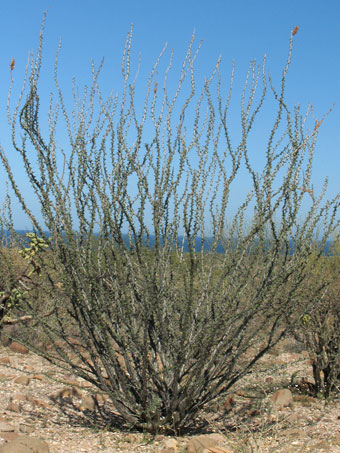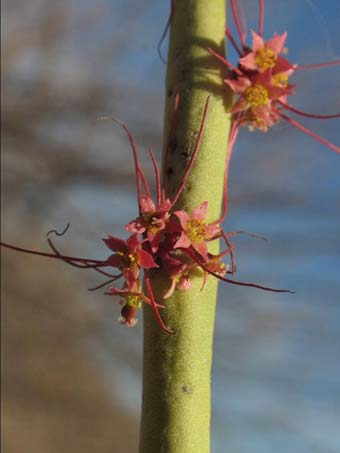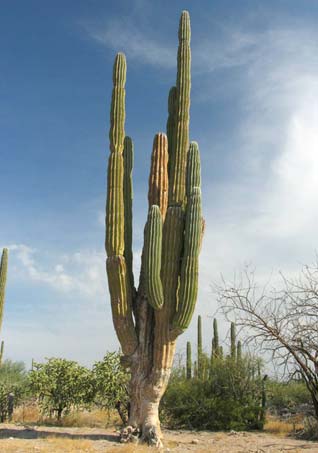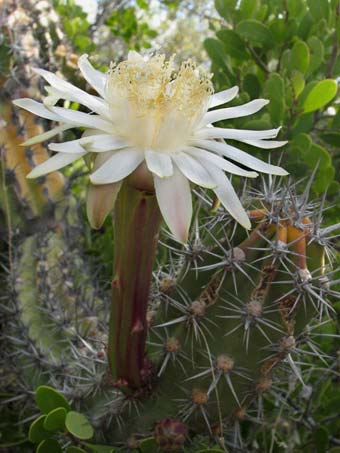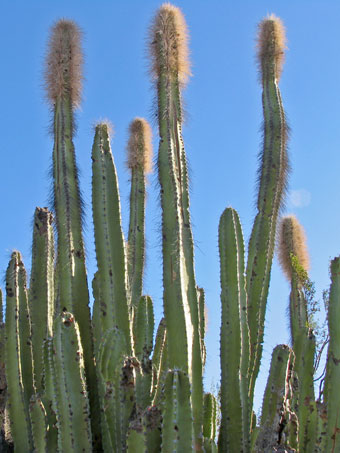This section contains entries about our botanizing in Baja California written for the UC BEE (Oct 2012 to Aug 2021)
and The UC Hive (2022-), monthly newsletters for volunteers and staff of the UC Berkeley Botanical Garden.
Click on any photo for a larger image.
BEE APR 2015
The Good, The Bad, and The Prickly: Botanical Adventures in Baja California - Part 3
This month, I'm finishing up this topic with the third (and final) installment that began with my February blog entry and continued with the March entry. Now, I'm going to cover some of Baja California's "prickly" plants.
No doubt, when the phrase "Baja California" and "prickly plants" come up at the same time, people imagine cacti, those ubiquitous desert dwellers and impalers of travelers unfortunate enough to meet them intimately. However, there is an amazing array of plants unrelated to the cacti that in their own right deserve both caution and respect. I find them all to be quite fascinating in their variety of attire.
Why do so many plants sport sharp projections? There are a large number of adaptive advantages to these structures. The most obvious is for defense against animals that might want to browse tasty parts, especially in young plants. For example, young Mesquite plants often have inordinately large spines (5-8 cm L and 2-3 mm D) on their otherwise spindly stems and branches, whereas fully mature trees lose their lower spines, and the upper and outer branches have ones only about 0.5-2 cm L (if they even bear spines at all). Larger trees and shrubs can usually survive some browsing because the proportion being grazed is low compared to the overall coverage, unlike in small or young plants.
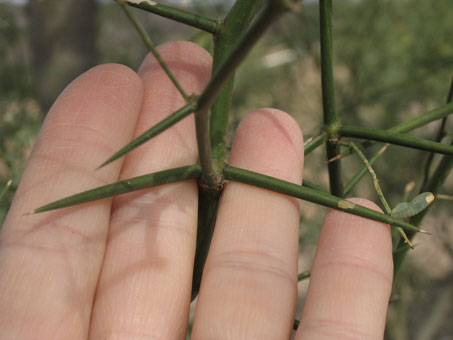
Five-plus cm long paired spines of a young Mesquite (Prosopis glandulosa var. torreyana, Fabaceae) are much larger than those of a mature tree & occur at the nodes & just above the leaf attachments.
Palo Adan or Tree Ocotillo (Fouquieria burragei and F. diguetii, Fouquieriaceae) is woody & spiny.

The cat-claw shaped nodal spines of Desert Ironwood (Olneya tesota, Fabaceae) are just as sharp as those of our feline friends. Pairs arise below the leaves.
The large spines of Ocotillo (Fouquieria splendens, Fouquieriaceae) and others in this genus are modified petioles (leaf stalks). The petiole is stiff but bears a leaf at the tip in the first season. In subsequent years, the leaves develop in fascicles in the axil of (above) the spine.
Some plants don't have spines, but instead have branches with very sharp tips or branchlets. When these are also arranged in such a manner as is seen in Frutilla or Boxthorn (Lycium spp., Solanaceae), Juaiven or Vomitbush (Atamisquea emarginata, Capperaceae), and Junco (Koeberlinia spinosa, Capparaceae), among others, the interwoven branches become almost impenetrable and their tiny leaves may not be worth the effort and risk of injury to browsers.
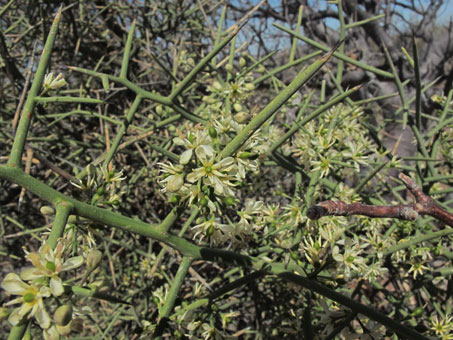
Junco (Koeberlinia spinosa, Capparaceae) has rigid, spinose branches. It is an inconspicuous shrub with green bark that is primarily leafless. When growing within other shrubs, they are almost invisible and easily mistaken for young Palo Verdes.
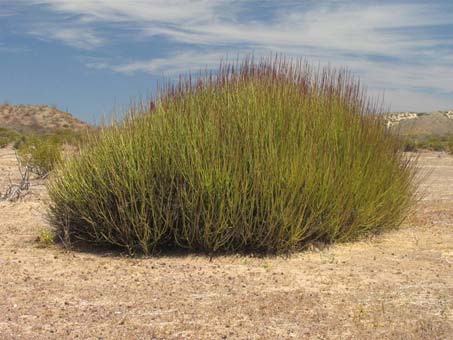
Espadín or Junco (Euphorbia ceroderma, Euphorbiaceae) has woody, pointed stems. Besides its tough stems, it has another deterrant to herbivory: it is full of latex sap. One time, I walked past a plant and I swear all I did was lightly brush a stem before it started oozing latex out of every joint.
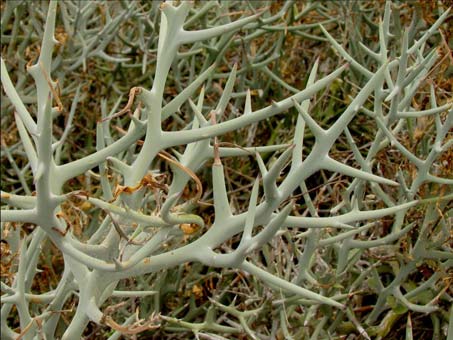
Palo Amargoso (Castela polyandra, Simaroubaceae) is generally leafless. Its branches are rigid and very hard. The plant photosynthesizes through its bark.
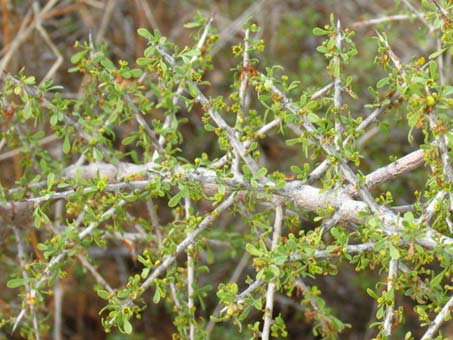
The branchlets of Palo Negrito or Bitter Condalia (Condalia globosa var. globosa, Rhamnaceae) spiral around the branch and are rigid with very sharp tips. This arrangement also reduces sun exposure on at least some parts of the branch throughout the day.
Both the leaves and flowers of Junco (Euphorbia ceroderma) are a rare sight. I was lucky to be visiting Punta Chivato one spring and many were blooming heartily. The thread-like structures behind the 3-4 mm D flowers are the leaves.

The flowers of Palo Amargoso (Castela polyandra, Simaroubaceae) are about 5-7 mm W and give rise to cherry red drupes about 1 cm D that are horribly bitter. Birds love them.
Spines aren't the only deterrant against herbivory (browsing). Some plants have sharp, glass-like hairs, sometimes with basal pustules full of an irritating liquid, that break off in the mouth and skin or shoot the liquid into the animal's tender tissues. They can also form impenetrable barriers at the insect level as well. Pega-pega (Rock nettle) and Pegarrropa (Blazing star) are densely hairy all over. Pegarropa's hairs are actually more like miniature grappling hooks that snag clothes and fur (and even bare skin) and get a free long-distance ride. This is great for the mature fruits that otherwise disperse their seeds near the parent when the plant is shaken by the wind or dries up, breaks off and eventually tumbles only a short distance away. Two species of Ratany (Krameria erecta and K. paucifolia, Krameriaceae) also have either grappling hooks or barbed spines on their fruit to aid in dispersal and deter consumption.

Pega-pega or Rock Nettle (Eucnide aurea, Loasaceae), a BCS endemic annual. Pustules at the hair bases are visible on the leaves.
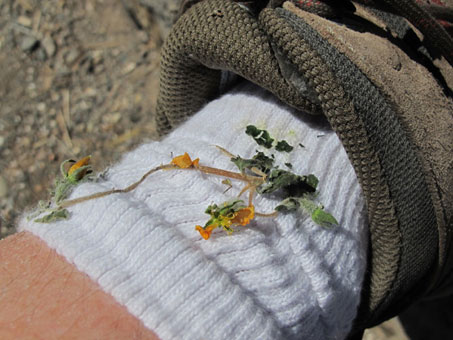
Mentzelia adhaerens: now you know why it's locally called Pegarropa (literally "sticks to clothes")
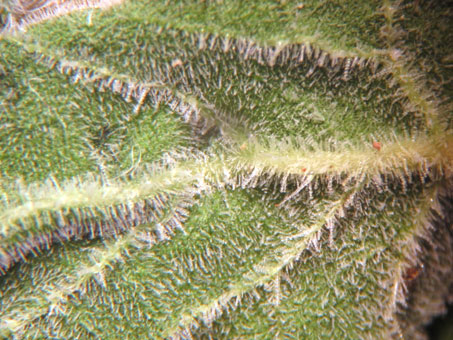
Microscopic view (c. 20x) of the hairs on the back of a Pegarropa leaf. Click on the image to see the stubby hairs with many rings of hooks.
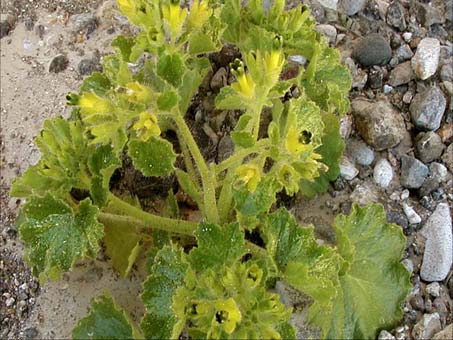
Another Pega-pega or Rock Nettle (Eucnide rupestris, Loasaceae). The hairs are almost as obnoxious as E. aurea.
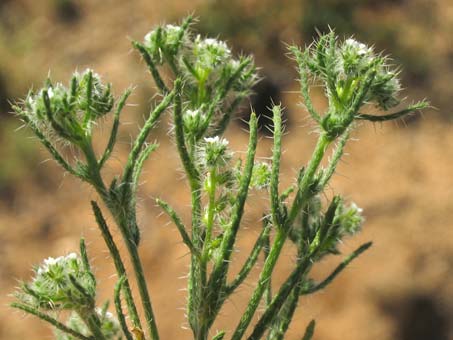
Forget-me-nots (Cryptantha spp.) have bristly hairs on their herbage, especially around the inflorescences. They decrease palatability as well as protect flowers and fruit from predation by insects to some degree, forming tiny cages enclosing the nutlets.
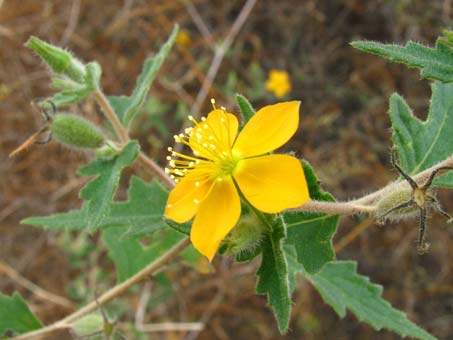
Pegarropa (Mentzelia adhaerens, Loasaceae). Relatives of this Blazing Star are also known as Velcro Plant in English.
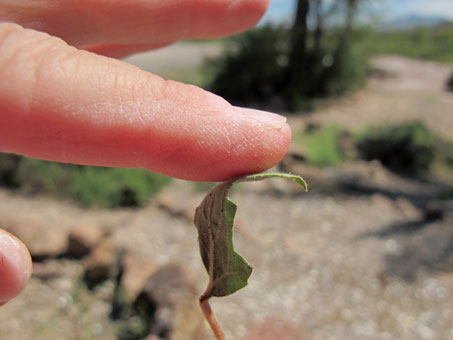
Mentzelia adhaerens, gotta love the name.
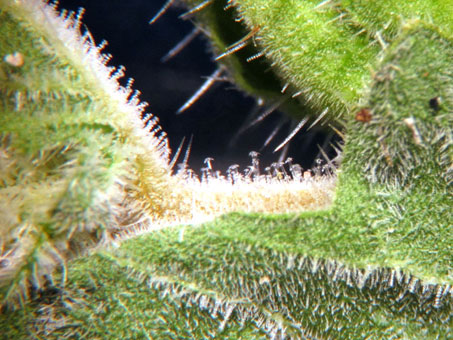
Image at c. 20x of the underside and leaf stalk of Pegarropa (lower portion) and fruit (upper center-right). Note that the fruit also has a few very sharp hairs. These are pustulate at their base.

Note the grappling hooks on the tips of a Krameria paucifolia fruit. The spines are quite soft, but stick like velcro.
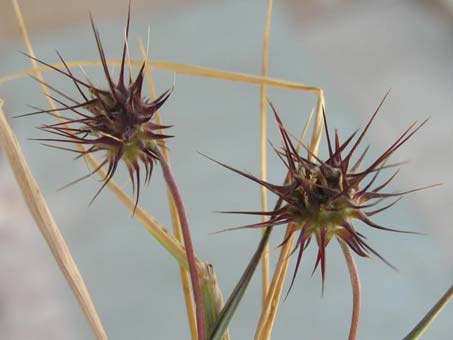
Even grasses in Baja can be mean. Huizapol or Beach sandbur (Cenchrus palmeri, Poaceae) is a native, annual pest. Each reddish or green bur is about 10-15 mm D (including the very sharp spines) and has several flowers. A viable seed will germinate inside the bur which then takes root.
And finally we get to the cacti. There are about 130 species on the peninsula and adjacent islands, with around 70% (±91 spp.) considered endemics. The spines of cacti have several functions, besides annoying inattentive tourists and botanists.
Cactus spines are modified leaves, and most cacti have lost their normal, photosynthetic leaves and replaced them with spines and photosynthetic stems. Adaptively, their primary function is to reduce water loss through transpiration from leaves. Since spines have no stomata (minute air holes), they can't lose water. Spines can also create shading for the plant and a protective covering of dense, overlapping spines even leads to increased humidity right next to the epidermis, which further reduces water loss through epidermal stomata. They do of course, protect the plant from browsing.
The smallest cacti in Baja California are the Pincushions (Mammillaria spp.). They may grow singularly or in clusters of several to many stems. They usually are not much more than 25-30 cm tall. The barrel cacti are also usually single-stemmed, but they may be anywhere from about 10 cm to over a meter tall and 30-40 cm W. Some of the largest barrels, mostly restricted to islands in the Gulf of California, may measure several meters tall.

Viejitos or Pincushion Cactus (Mammillaria dioica, Cactaceae). Many of these are also called Fish Hook Cactus because the central spine of each cluster is hooked at the end. Size: 5 cm D.
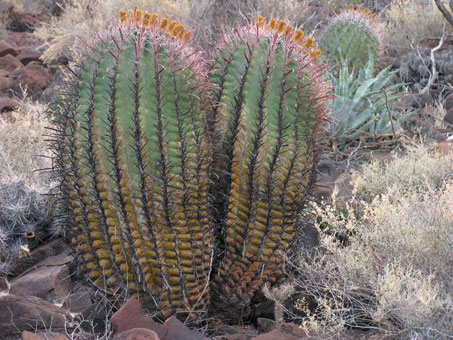
Two large barrel cacti (Ferocactus peninsulare), one of many BC endemics. Size: about 60 cm.
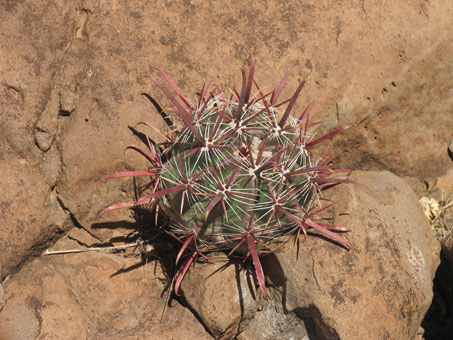
A young endemic Biznaga or Barrel Cactus (Ferocactus peninsulae var. peninsulae) probably about 20 cm D. This species has a strongly hooked and flattened central spine and bristly radial spines.
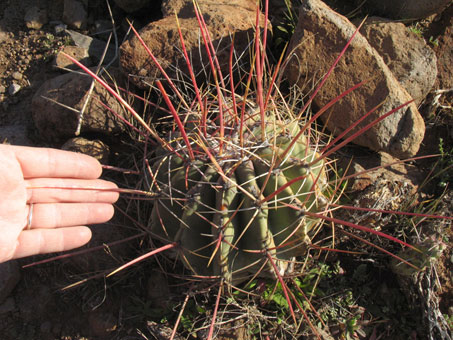
A small barrel cactus (Ferocactus emoryi var. rectispinus). This species has straight spines up to 20 cm long, often longer than the cactus is wide. Size: about 15 cm D, spines 10+ cm.
There are a large number of Cylindropuntia and Opuntia species in Baja California. People are often familiar with Jumping Cholla and Teddy Bear Cholla which look so fuzzy and soft, or Prickly Pears, which have tasty fruit. However, the spines of both genera are not at all friendly. Because they have microscopic, downward pointing barbs, they usually require a really good yank with pliers to remove them from tender flesh. They are also tricky because as you extricate yourself from one part of a stem, an adjacent part can easily take hold.
The two chollas most common in our area are Cholla Pelona or Chain-link Cholla (Cylindropuntia cholla) and Cholla Barbona (C. alcahes var. alcahes). Both are endemic and have a very similar habit and size. They differ most noticeably in their vestiture of spines and the photos below show this difference clearly. Both of these chollas reproduce primarly through vegetative means: a segment of stem falls off, or a fruit lands on the ground, and takes root from a node (where spines, flowers, fruit, and roots all can arise). The new plant is a clone of the parent. Cattle seem to be deterred very little by the spines of Cholla Pelona, and are often seen with chunks stuck into their lips, noses, cheeks, flanks and legs. They may eventually break off from the spines and take root far away. Dense patches of this species is often a good indication of overgrazed land. Chollas are also memorable for their glochids, tiny spines in dense clusters at the base of the larger, radial and central spines. Some species, like Beavertail Cactus, only have glochids. These spines easily pierce the skin and then break off just above skin level and can drive a person crazy because they are difficult to remove and incredibly irritating for several days.

Cholla Pelona or Chain-link Cholla (Cylindropuntia cholla, Cactaceae). The stems have tubercles that, in my opinion, give them a chain-link fence appearance.
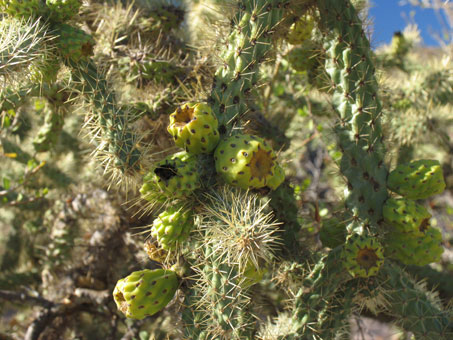
The Spanish name for this cholla, Cholla Barbona, translates to Bearded Cholla (C. alcahes var. alcahes).
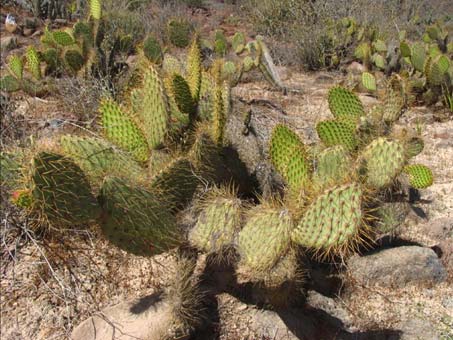
Nopal or Prickly Pear Cactus (Opuntia sp.) have flattened pads (stems). Ours have long spines and prominent glochids.

However, the flowers and fruits of Cholla Pelona or Chain-link Cholla (Cylindropuntia cholla, Cactaceae) often arise from the fruit of a previous season, forming actual chains of fruit.
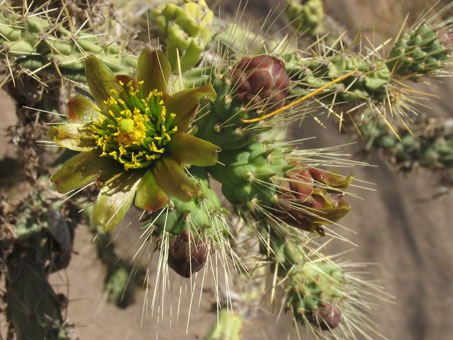
The young fruit of Cholla Barbona (C. alcahes var. alcahes) are incredibly spiny. The spines are generally lost with age (photo, left).

Nopal flower (Opuntia sp.), San Juanico, Baja California Sur.
The columnar cacti are the largest species here, ranging in size from under a meter to 20 meters high and weighing many tons. Most have copious, edible fruit highly prized by animals and humans alike. The spines, while often large, somehow seem not so menacing as those of the chollas. Of course, I'd prefer not to be impaled by any of these beauties, but I find them somewhat easier to avoid than the sneaky chollas with their stems well-hidden within a larger, more interesting bush or sticking out slightly into the trail, as if waiting to snag a calf or knee.
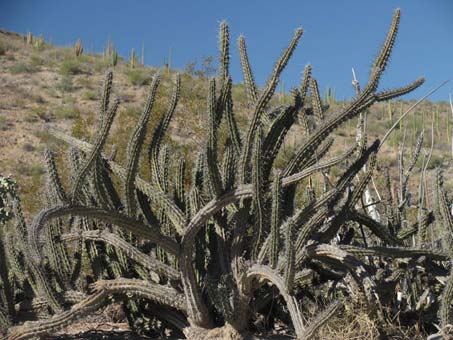
Pitahaya Agria or Galloping Cactus (Stenocereus gummosus) often forms widespread thickets. A stem that droops down onto the ground will take root and send up new vertical stems that in turn eventually droop down and take root. The galloping is very slo-mo...
The Cardón or Elephant Cactus (Pachycereus pringlei) has been called the world's largest cactus, reaching 20 meters. It loses its spines with age.
While very bristly, the fruit of Cardón is juicy and quite edible.
Large, tubular flowers of Pitahaya Agria or Galloping Cactus (Stenocereus gummosus) open in the late afternoon for night-time pollination.

Flowers of the Cardón are large and pollinated by bats at night. Diurnal pollinators include bees, wasps and even white-winged doves.
Stems of Garambullo or Old Man Cactus (Lophocereus schottii); some are sexually mature and have developed a pseudocephalum from within which flowers will arise.
Well, that’s it for this series. I hope that it has been informative. Perhaps the most important take-away will be that the plants of the Baja California peninsula are many and diverse. You’ve seen that they range from tiny annual parasites growing on other tiny annual plants to one of the world´s largest arborescent cactus. You’ve also learned about the many different types of mechanisms that have allowed them to adapt and thrive over a broad range of habitats and environmental conditions. Hopefully, you will be fortunate to see these plants up close and personal some day. Just remember to look before you sit!
Until next month, hasta la próxima…
Debra Valov—Curatorial volunteer



